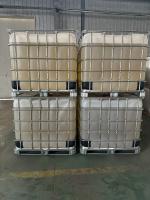anionic polyacrylamide nalclear 7763 and Nalclear 7768 can be replaced by Chinafloc EM series
nalclear 7763 and Nalclear 7768 are two kinds of anionic polyacrylamide meulsion ,mainly used for water treatment and sludge dewatering,chinalfoc Em3018 and Chinalfoc EM2005 can replace of them with good performance.
Anionic polyacrylamide (PAM) emulsion plays a significant role in water treatment and sludge dewatering processes. To understand its main applications, it's essential to delve into the specifics of how anionic polyacrylamide functions, its effectiveness in various scenarios, and the best practices for its use.
1. Anionic Polyacrylamide in Water Treatment:
-
Coagulation and Flocculation: One of the primary applications of anionic PAM in water treatment is in the coagulation and flocculation process. During water treatment, small particles and colloids suspended in water need to be removed to make the water clear and safe for consumption or discharge. Anionic PAM, when added to the water, facilitates the aggregation of these particles into larger flocs, making them easier to remove through sedimentation or filtration.
-
Mechanism of Action: Anionic PAM carries a negative charge, which allows it to effectively bind with positively charged particles (like certain types of dirt, organic matter, and metal ions). This interaction helps overcome the repulsive forces between particles, enabling them to come together and form larger, more settleable flocs.
-
Effectiveness in Various Water Types: The effectiveness of anionic PAM is influenced by the characteristics of the water being treated, such as pH, temperature, and the nature and concentration of suspended particles. Different molecular weights and charge densities of anionic PAM are used depending on these factors to optimize the flocculation process.
2. Anionic Polyacrylamide in Sludge Dewatering:
-
Role in Dewatering Processes: In sludge dewatering, the main challenge is to separate water from the solid waste material. Anionic PAM is used to enhance this separation process. When added to sludge, it facilitates the agglomeration of fine particles into larger flocs, thereby improving the efficiency of dewatering equipment like belt presses, centrifuges, and filter presses.
-
Improving Sludge Handling: By increasing the size and stability of the flocs, anionic PAM aids in creating a more dewaterable sludge. This results in a reduction in the volume of the sludge and increases the dryness of the sludge cake, making its handling, transportation, and disposal more efficient and cost-effective.
-
Applications in Different Types of Sludge: Anionic PAM is particularly effective in dewatering organic sludges, which are common in municipal wastewater treatment plants, as well as certain industrial sludges. The choice of anionic PAM (in terms of molecular weight and degree of anionicity) depends on the nature of the sludge and the specific requirements of the dewatering process.
3. Technical Considerations in the Use of Anionic PAM:
-
Dosage and Dilution: The effectiveness of anionic PAM is highly dependent on the correct dosage and proper dilution. Overdosing can lead to reduced efficiency, while underdosing may not provide the desired level of flocculation. The optimal dosage is determined by jar tests or pilot trials.
-
Application Method: The method of applying anionic PAM to the water or sludge is crucial. Proper mixing and dispersion are necessary to ensure that the polymer contacts and interacts effectively with the particles.
-
Handling and Storage: Anionic PAM emulsions require careful handling and storage. They should be protected from extreme temperatures and direct sunlight to maintain their efficacy.
4. Environmental and Safety Aspects:
-
Environmental Impact: While anionic PAM itself is generally considered safe and non-toxic, its environmental impact depends on the nature of the residual monomers and any additives used in the formulation. Modern manufacturing practices typically ensure that the levels of these potentially harmful substances are minimal.
-
Safety in Handling: Proper safety precautions should be taken when handling anionic PAM, especially in concentrated form. It can be slippery and, if inhaled as a dust, may cause respiratory issues.
5. Advantages and Limitations:

